Ecological Domain and Automotive Hardware Expansion Research Report, 2024
Automotive Ecological Domain Research: How Will OEM Ecology and Peripheral Hardware Develop?
?
Ecological Domain and Automotive Hardware Expansion Research Report, 2024 released by ResearchInChina recently delves in the dynamics of automotive ecological domain in peripheral hardware expansion, supplier ecological solutions and OEM ecological implementation, and comprehensively combs and forecasts the development and future trends of automotive ecological domain.
First, the ecological domain will realize large-scale interconnection between? IVI and external software and hardware, and obtain efficient collaborative perception and calculation of multiple devices.
The automotive ecological domain refers to the software and hardware ecosystem centering on IVI and including various peripheral devices. The IVI can call terminal sensors (such as mobile phones, cameras, UAVs, tablet PCs, etc.) and computing power, and attain efficient collaborative perception and computing of multiple devices through the cloud platform. The ecological expansion of automotive applications has always been a hot spot for OEMs and suppliers, and the development can be divided into three stages. In the first stage, ecological expansion is mainly realized through? IVI application mall. In the second stage, the mobile phone ecosystem will be transferred to IVI through phone-vehicle interconnection. In the third ecological stage, watches, cameras, tablet PCs, and even UAVs, smart homes, seats, etc. are added.
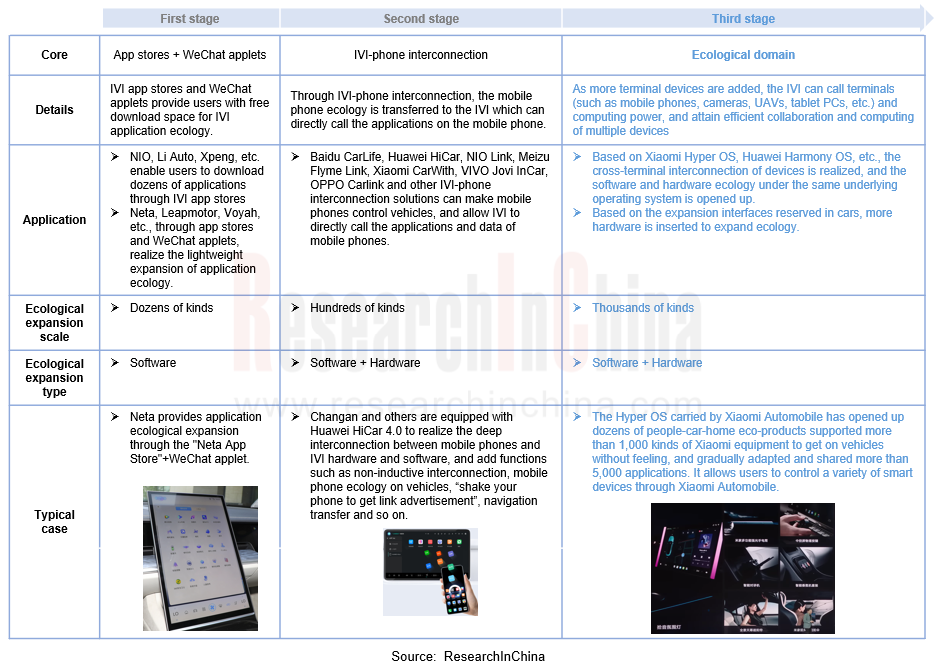
Xiaomi Automobile is a typical ecological domain constructor. Relying on its HyperOS and Mi Home ecosystem, Xiaomi Automobile can support 1,000+ Mi Home devices to get on vehicles seamlessly, and can be connected without passwords under the same account to realize automatic scenario linkage.
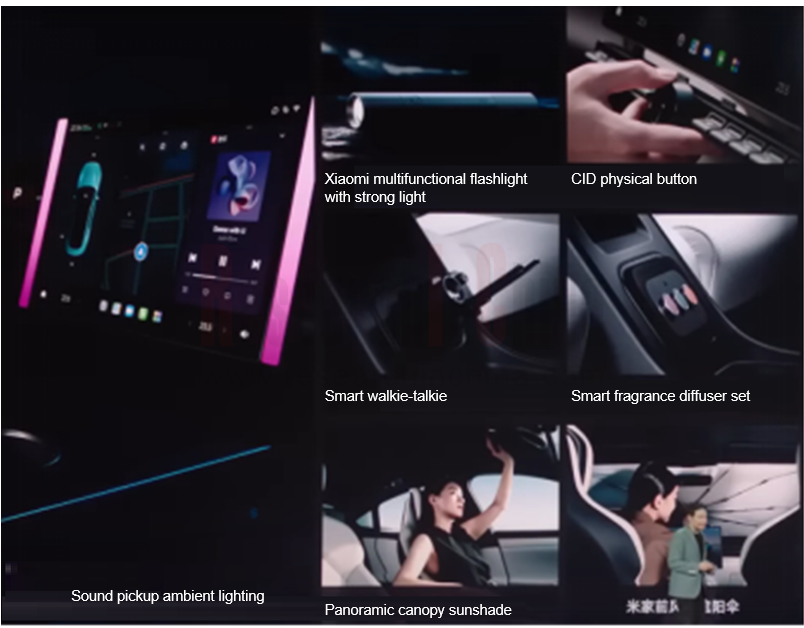
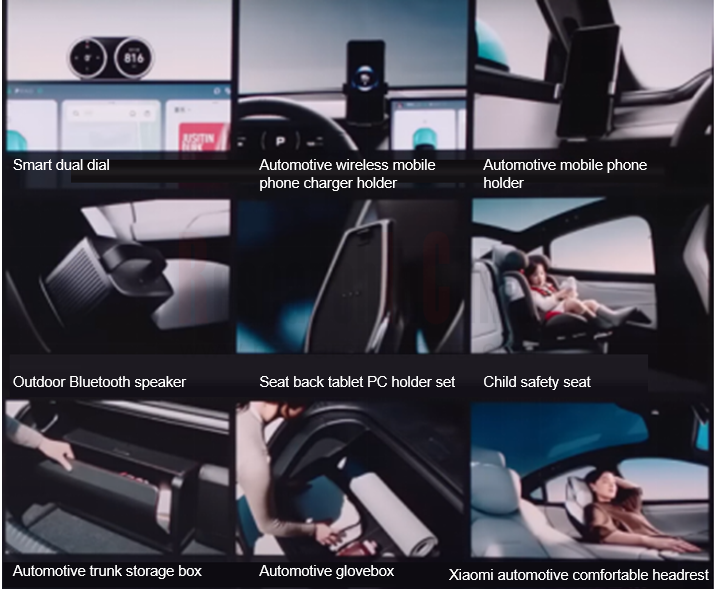
?
In order to support ecological expansion, Xiaomi has reserved a large number of interfaces in central instrument displays (CIDs), center consoles and seat back. For instance:
?PIN points are reserved around CIDs to expand interfaces, hardware devices of the third parties can realize plug-and-play, and there is a magnet at the bottom of the screen to attract a group of physical buttons for the purpose of control in vehicles.
?The storage space of center consoles reserves hardware interfaces, power interfaces and magnetic attraction, which can expand more innovative hardware of the third parties, such as Mi Home automotive fragrance diffusers.
?The back of seats features 22.5W magnetic charging. After Xiaomi’s tablet PC is adsorbed, it will directly become the original IVI, which can control 30+ automotive systems such as navigation, air conditioning, seating, audio and video. In addition, the IVI has CarPlay and AirPlay wireless connections, and the expansion of the seat back also supports iPad, which can control air conditioning, music and seats.
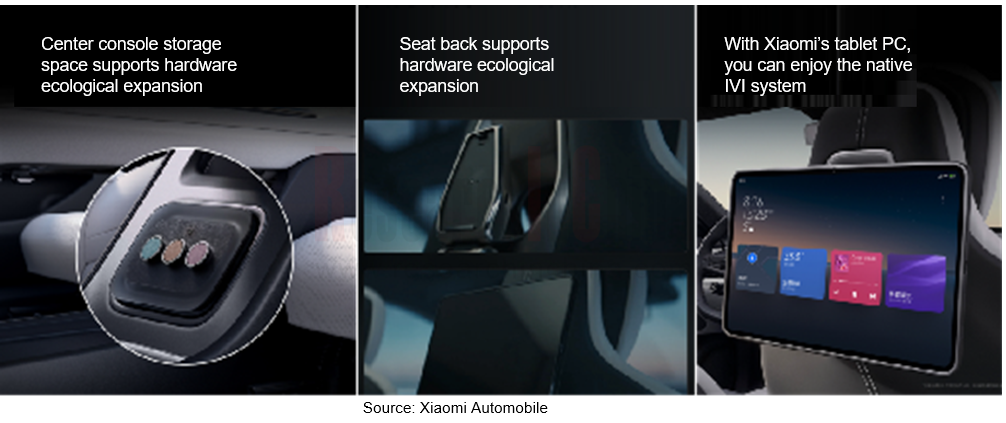
Second, OEMs often start from scenarios to design the ecological domain expansion.
According to Ecological Domain and Automotive Hardware Expansion Research Report, 2024 by ResearchInChina, the automotive ecology has included hundreds of kinds of hardware and thousands of accessible hardware devices. From OEMs' point of view, Xiaomi Automobile can support the first batch of 1,000+ Mi Home devices to get on vehicles, GAC's Green Smart Car Home can support interconnection with 4,000+ devices, and Huawei's house-wide intelligence is connected with 7,000+ smart items carrying HarmonyOS.
?
Facing massive hardware resources, OEMs often conduct hardware layout from scenarios when designing the ecological domain, especially typical scenarios like smart home, gaming, viewing, karaoke, virtual reality, shooting, office, camping, charging, smart mobility, sports and health. At present, most of automotive hardware products are optional, and some of them can be purchased conveniently through official App stores of OEMs.
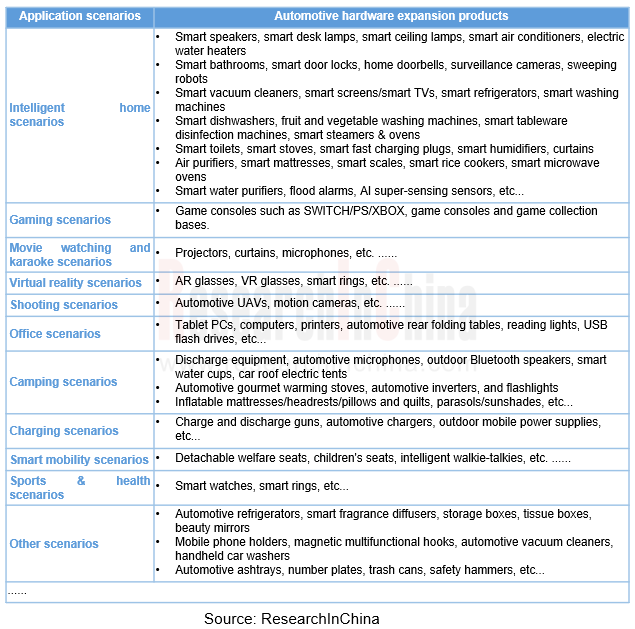
1.In entertainment scenarios, OEMs introduce a series of entertainment equipment such as game consoles (SWITCH, PS, etc.), movie-watching equipment, microphones, automotive UAVs, sports cameras, etc. to link multi-terminal information with IVI, thus improving playability of cockpits.
?
Hardware interconnection cases in entertainment scenarios:
① Dongfeng Warrior is equipped with a UAV system: Warrior 917, which was launched in August 2023, is equipped with a UAV system. The system is composed of a S400 UAV from GDU and a control system, focusing on safe and intelligent outdoor scenarios of IVI integration. Its roof can be expanded to be an apron. In addition to regular flying functions, the UAV can monitor roads, survey road terrain, slope, angle and other environmental information, and support synchronous intelligent path planning.
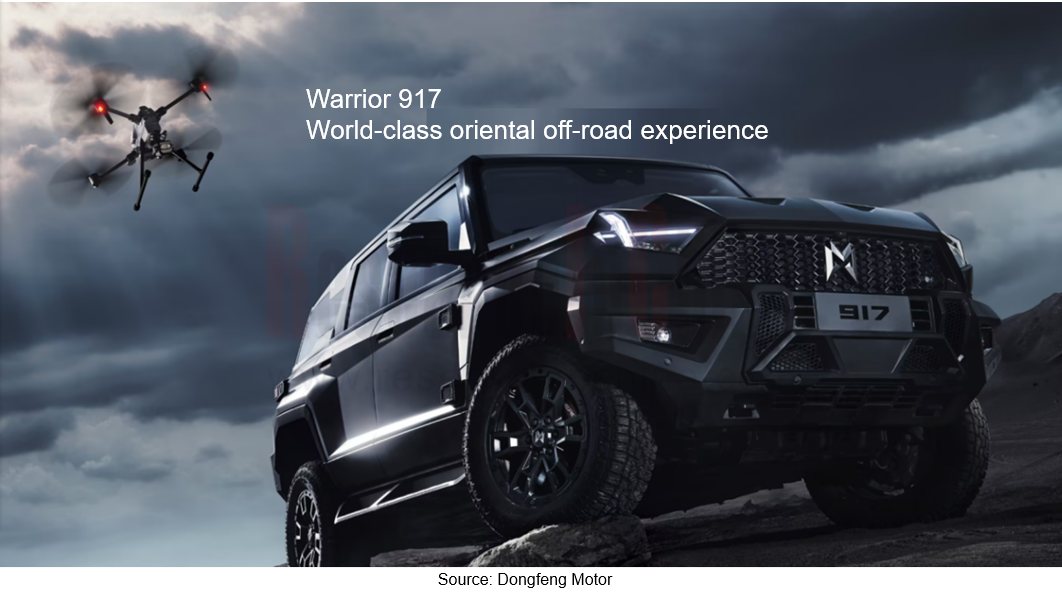
?② Avatr has a custom karaoke microphone: Avatr boasts a wireless karaoke microphone (dual microphone) customized for the smart cockpit, with a built-in DSP processing chip, which can beautify human voice, optimize reverberation curve, and support linkage with the screen, sound and atmosphere lights in the cockpit.
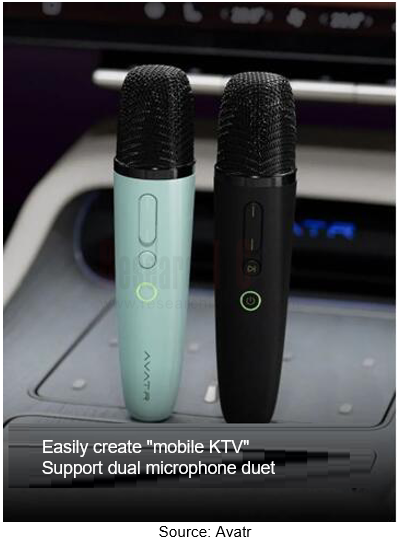
?2.In smart home scenarios, OEMs have promoted "the whole ecology covering people, cars and home". Users can remotely control and manage smart home devices (including air conditioners, water heaters, lighting, security systems, etc.) through mobile phones, cars and other devices.
?
Hardware interconnection cases in smart home scenarios:
① AITO and various smart home terminals realize car-home linkage: AITO integrates the capabilities of all kinds of terminals including smart screens, smart air conditioners, sweeping robots and home surveillance cameras in smart home scenarios based on HarmonyOS. In addition, AITO also supports preset scenarios like "go home happily", "leave home confidently”. For example, car owners can turn on air conditioners, lights, TV sets and music at home with one click on their way off work.
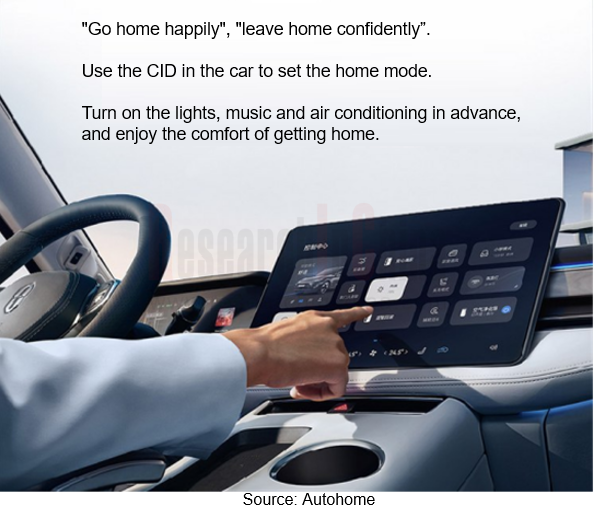
?② GAC's “Green Smart Car Home” solution enables car-home interaction: GAC's “Green Smart Car Home” supports the interconnection of more than 1,000 home appliance brands and 4,000+ devices. It allows car owners to remotely control smart home appliances in their cars through voice, touch screens, etc. It will also wake up and control vehicle functions at home.
?
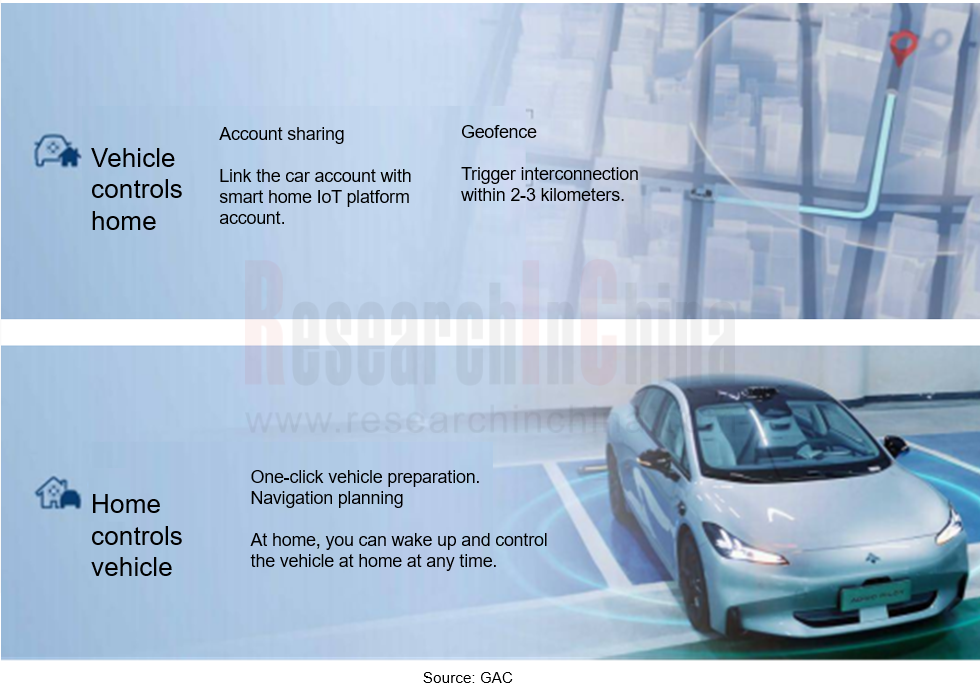
Third, the way to expand automotive ecological domain
In the process of ecological domain expansion, OEMs give priority to mobile phones as the entry point for ecological domain expansion. Through the deep interconnection between mobile phones and IVI, functions like computing power sharing, data seamless connection and hardware sharing can be attained, bringing users a more convenient and intelligent mobility experience. At the same time, massive user habit data and ecosystem on mobile phones are migrated to cars. On this basis, OEMs gradually expand interconnection with terminal products such as cameras, UAVs and tablet PCs, and build a perfect intelligent ecosystem. This expansion process not only provides users with richer functions and services, but also strengthens the competitiveness of OEMs in the field of intelligent ecology.
?
The cooperation between OEMs and mobile phone/technology vendors can be summarized and classified into the following modes: OEMs acquire mobile phone vendors, OEMs conduct independent R&D, OEMs cooperate with technology companies in research and development, mobile phone vendors manufacture cars (through cooperation), OEMs cooperate with mobile phone/ technology vendors. From the perspective of cooperation modes, some OEMs tend to get through the underlying operating systems of mobile phones and IVI, and promote Internet of Everything based on a unified platform. Other OEMs focus on improving IVI systems and seek cooperation with other vendors to achieve partial IVI interconnection.
?
In addition, it is worth noting that AM automotive hardware products are also an indispensable part of building a complete automotive ecosystem. When comparing the automotive hardware products of OEM app stores, we find that Huawei and Xiaomi, as top smart phone players, have a huge user base and mature e-commerce platforms (such as Huawei Mall and Xiaomi Mall). These platforms not only sell core products such as mobile phones, but also offer products in many fields such as smart home, smart wear and accessories. Therefore, for the car owners of Xiaomi and Huawei HarmonyOS, they can completely purchase automotive hardware products which they desire through these existing e-commerce platforms instead of OEM app stores.
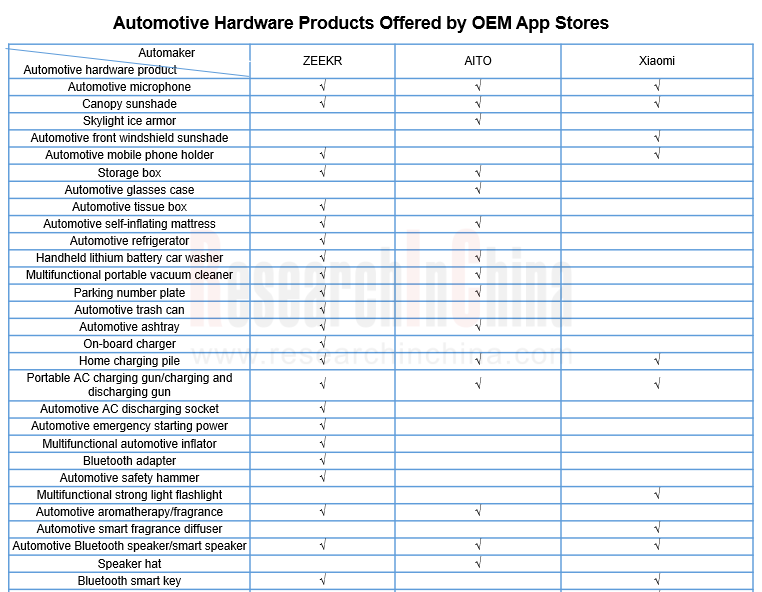
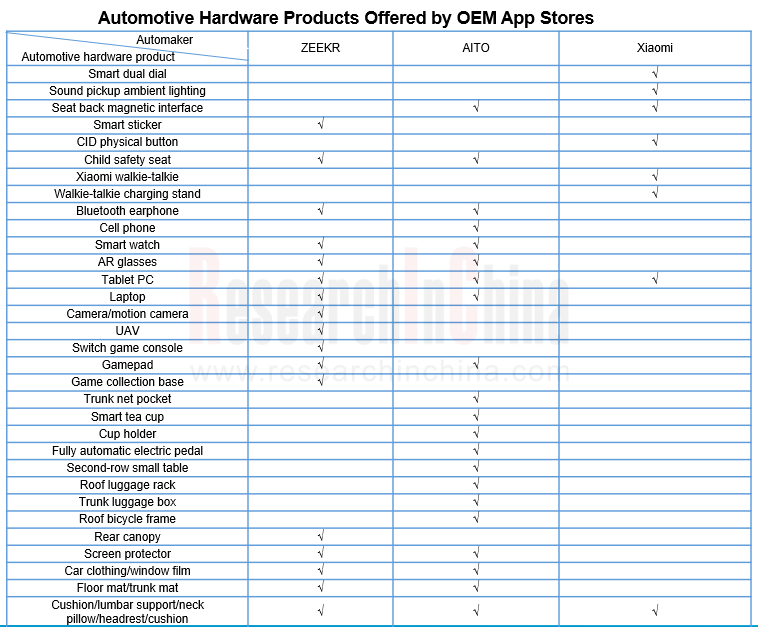
Autonomous Driving SoC Research Report, 2025
High-level intelligent driving penetration continues to increase, with large-scale upgrading of intelligent driving SoC in 2025
In 2024, the total sales volume of domestic passenger cars in China was...
China Passenger Car HUD Industry Report, 2024
ResearchInChina released the "China Passenger Car HUD Industry Report, 2025", which sorts out the HUD installation situation, the dynamics of upstream, midstream and downstream manufacturers in the HU...
ADAS and Autonomous Driving Tier 1 Suppliers Research Report, 2025 – Chinese Companies
ADAS and Autonomous Driving Tier 1 Suppliers Research Report, 2025 – Chinese Companies
Research on Domestic ADAS Tier 1 Suppliers: Seven Development Trends in the Era of Assisted Driving 2.0
In the ...
Automotive ADAS Camera Report, 2025
①In terms of the amount of installed data, installations of side-view cameras maintain a growth rate of over 90%From January to May 2025, ADAS cameras (statistical scope: front-view, side-view, surrou...
Body (Zone) Domain Controller and Chip Industry Research Report,2025
Body (Zone) Domain Research: ZCU Installation Exceeds 2 Million Units, Evolving Towards a "Plug-and-Play" Modular Platform
The body (zone) domain covers BCM (Body Control Module), BDC (Body Dom...
Automotive Cockpit Domain Controller Research Report, 2025
Cockpit domain controller research: three cockpit domain controller architectures for AI Three layout solutions for cockpit domain controllers for deep AI empowerment
As intelligent cockpit tran...
China Passenger Car Electronic Control Suspension Industry Research Report, 2025
Electronic control suspension research: air springs evolve from single chamber to dual chambers, CDC evolves from single valve to dual valves
ResearchInChina released "China Passenger Car Elect...
Automotive XR Industry Report, 2025
Automotive XR industry research: automotive XR application is still in its infancy, and some OEMs have already made forward-looking layout
The Automotive XR Industry Report, 2025, re...
Intelligent Driving Simulation and World Model Research Report, 2025
1. The world model brings innovation to intelligent driving simulation
In the advancement towards L3 and higher-level autonomous driving, the development of end-to-end technology has raised higher re...
Autonomous Driving Map (HD/LD/SD MAP, Online Reconstruction, Real-time Generative Map) Industry Report 2025
Research on Autonomous Driving Maps: Evolve from Recording the Past to Previewing the Future with "Real-time Generative Maps"
"Mapless NOA" has become the mainstream solution for autonomous driving s...
End-to-End Autonomous Driving Research Report, 2025
End-to-End Autonomous Driving Research: E2E Evolution towards the VLA Paradigm via Synergy of Reinforcement Learning and World Models??The essence of end-to-end autonomous driving lies in mimicking dr...
Research Report on OEMs and Tier1s’ Intelligent Cockpit Platforms (Hardware & Software) and Supply Chain Construction Strategies, 2025
Research on intelligent cockpit platforms: in the first year of mass production of L3 AI cockpits, the supply chain accelerates deployment of new products
An intelligent cockpit platform primarily r...
Automotive EMS and ECU Industry Report, 2025
Research on automotive EMS: Analysis on the incremental logic of more than 40 types of automotive ECUs and EMS market segments
In this report, we divide automotive ECUs into five major categories (in...
Automotive Intelligent Cockpit SoC Research Report, 2025
Cockpit SoC research: The localization rate exceeds 10%, and AI-oriented cockpit SoC will become the mainstream in the next 2-3 years
In the Chinese automotive intelligent cockpit SoC market, althoug...
Auto Shanghai 2025 Summary Report
The post-show summary report of 2025 Shanghai Auto Show, which mainly includes three parts: the exhibition introduction, OEM, and suppliers. Among them, OEM includes the introduction of models a...
Automotive Operating System and AIOS Integration Research Report, 2025
Research on automotive AI operating system (AIOS): from AI application and AI-driven to AI-native
Automotive Operating System and AIOS Integration Research Report, 2025, released by ResearchInChina, ...
Software-Defined Vehicles in 2025: OEM Software Development and Supply Chain Deployment Strategy Research Report
SDV Research: OEM software development and supply chain deployment strategies from 48 dimensions
The overall framework of software-defined vehicles: (1) Application software layer: cockpit software, ...
Research Report on Automotive Memory Chip Industry and Its Impact on Foundation Models, 2025
Research on automotive memory chips: driven by foundation models, performance requirements and costs of automotive memory chips are greatly improved.
From 2D+CNN small models to BEV+Transformer found...